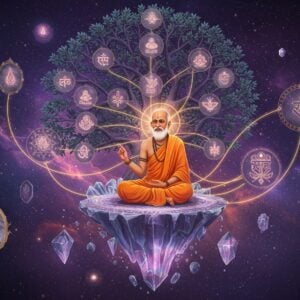
Dive into the enchanting world of Kamadhenu and Kalpavriksha, two celestial figures deeply woven into the fabric of Indian culture and spirituality. These potent symbols of abundance and wish-fulfillment have graced Hindu mythology for centuries, shaping beliefs, inspiring rituals, and enriching lives even today. Join us as we explore their profound cultural significance and how they continue to resonate in our modern world.
The Divine Kamadhenu: A Mother’s Bounty
Kamadhenu, the divine wish-fulfilling cow, occupies a revered place in Hindu mythology. Also known as Surabhi, her name originates from “Kamaduha,” meaning “the cow of plenty,” reflecting her power to fulfill all desires. Ancient scriptures, such as the Puranas, recount her emergence during the Samudra Manthan, the epic churning of the cosmic ocean. Considered the mother of all cows, she embodies prosperity, abundance, and the Earth’s nurturing essence. Her very presence sanctifies the cow, an animal revered in Hinduism for its purity, fertility, and selfless giving.
Often depicted as a radiant white cow with a divine aura, she sometimes appears with wings and a human-like face, hinting at her celestial origins. It is believed that the forms of various deities reside within her, underscoring her sacred nature. Legend has it that Kamadhenu can grant any wish and provide her owner with anything their heart desires. Hindus regard all cows as embodiments of Mother Kamadhenu, believing that worshipping them invites prosperity and spiritual blessings.
Kamadhenu is closely associated with Sage Vashishta, residing in his hermitage and providing for all his needs. She is also linked to Lord Vishnu, further emphasizing her divine connections. You can bring the blessings of Kamadhenu into your home with a beautiful brass Kamadhenu statue from poojn.in. Browse our collection here.
The Sacred Kalpavriksha: A Tree of Dreams
Kalpavriksha, the wish-fulfilling tree, is another captivating figure in Hindu mythology. Like Kamadhenu, it emerged from the Samudra Manthan, embodying prosperity, immortality, and strength. Ancient texts and mythological stories celebrate its power to grant any wish, offering a direct line to the universe for our hopes and dreams. Its presence encourages us to see planting trees and preserving nature as sacred acts.
The Devas (gods) planted Kalpavriksha in Indralok (heaven), where it became a source of unending abundance. Indra’s Devaloka is said to house five Kalpavrikshas, each fulfilling different desires. Kalpavriksha is closely associated with various deities and is often depicted in Svarga (heaven), particularly in Indra’s gardens. Across India, certain trees are revered as Kalpavriksha, such as the Mahura tree (Madhuca longifolia) in Maharashtra and the banyan tree (Ficus benghalensis) throughout the country.
Bring the sacred energy of Kalpavriksha into your life with pooja essentials. Explore our range of pure cotton wicks and ghee for aarti, perfect for honoring the divine.
Symbolism and Significance: Timeless Wisdom
Both Kamadhenu and Kalpavriksha hold deep cultural significance as symbols of wealth, fertility, and the fulfillment of desires. Their legends shape festivals, rituals, and traditional values, fostering respect for nature and all living beings. Their stories subtly encourage environmental consciousness and sustainability, while their presence in art, from ancient sculptures to modern paintings, reflects their enduring relevance.
You can explore a world of spiritual items at poojn.in, from holy books to holy clothing. Enhance your spiritual practice with authentic items, conveniently delivered to your doorstep.
Living Traditions: Embracing the Past in the Present
In contemporary India, Kamadhenu and Kalpavriksha continue to influence spiritual practices and beliefs. Their symbols permeate daily life through rituals, cultural expressions, and artistic representations, strengthening our connection to traditional values amidst modern advancements. These enduring myths are adapted in popular culture and media, fostering a sense of cultural identity. Online platforms, like poojn.in, make related religious products more accessible, supporting the preservation of our rich cultural heritage. Looking for decorative items for your home? Poojn.in offers a wide variety of spiritual and cultural décor.
Frequently Asked Questions
What is the significance of Kamadhenu and Kalpavriksha? Kamadhenu, the divine cow, and Kalpavriksha, the wish-fulfilling tree, are powerful symbols of abundance, prosperity, and wish fulfillment. They represent the divine blessings that flow when we live in harmony with nature and the spiritual world.
How are Kamadhenu and Kalpavriksha worshipped? While specific rituals may vary, reverence for Kamadhenu often involves caring for cows and offering them food and water. Honoring Kalpavriksha may include planting and nurturing trees, or performing rituals under sacred trees like the Banyan. Explore our range of high-quality incense from Falcon to enhance your worship rituals.
What is the mythological origin of Kamadhenu and Kalpavriksha? Both emerged during the Samudra Manthan, the churning of the cosmic ocean, alongside other divine treasures like Lakshmi, the goddess of wealth. This shared origin highlights their interconnectedness and their significance as gifts from the gods.
How can I learn more about these sacred symbols? Explore our blog for articles on Rudraksha and Tulsi, and sacred Hindu plants. You can also find information on Yantras and Yagyas and Chhattisgarh temples to deepen your understanding of Indian spirituality. For those interested in adding a touch of traditional art to their homes, poojn.in offers a unique collection of handcrafted wooden masks.
At poojn.in, we offer a wide selection of puja items and spiritual products to help you connect with these divine energies. Visit our website or contact us for personalized guidance.


